 |
|
|
The Greek and Byzantine Roots of Palermo |
|
| Palermo is a cosmopolitan city with a unique style, influenced by many cultures. I was looking for the Ancient Greek and Byzantine legacy during my 2005 tour with the Arba Sicula society for the promotion of Sicily and Sicilians. I was amazed by the Greek presence in Palermo, the capital of Sicily. |
|
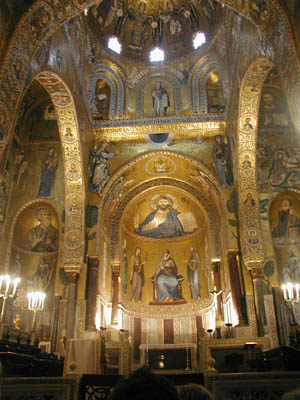 Monreale with Byzantine mosaics. Photos by Catherine Tsounis. |
The city was an international capital of the Norman dynasty at the time of the Crusades. Roger the II in the 1200's began an ambitious public works project of monasteries and churches. The only site that I have seen seven foot tall authentic Byzantine wood carved crosses was in the monastery of San Giovanni Degli Eremiti. I never saw this anywhere in Greece, when I visited monasteries and museums under an Alexander Onassis Public Foundation Scholarship in 2003. Byzantine crosses are prominently displayed throughout the island. Even in the small, Eastern Long Island town of Mattituck, the local pizzeria called "The Sicilian" on Route 25, owned by Giacomo and Maria Terranova, has a prominent Byzantine cross from Palermo displayed. One does not need to be a scholar to recognize one fact: the 21st century Sicilian remembers and preserves his/her Greek and Byzantine roots.
|
|
The Norman Palace is unique monument. It is the seat of the Sicilian Regional Assembly. Sweeping Corinthian columns, Ancient Greek and Byzantine iconography predominate throughout the edifice. The Parliament room has an imposing wall painting of the Goddess Athena giving wisdom to all. Our guide revealed that "the art work was created by Byzantines from Constantinople who lived in prosperity under Norman rule for 100 years with the Jews and Moors." These groups created the golden age under Roger II, King of Sicily and Frederick II of Swabia. Throughout the Norman Palace, mosaics from Greek mythology and Byzantine iconography are seen. The Palatine Chapel in the Norman Palace has spectacular iconography and frescoes in every space. The chapel, built by Roger II from 1130-1143 A.D., reminds one of a Greek Orthodox Church. The Palatine Chapel's dome has the "All Seeing Pantocrator" fresco of Jesus. Greek writing describes every religious theme of Jesus' life such as the "flight into Egypt", and "Jesus' Entry into Jerusalem." I felt I was in an incredibly beautiful Greek Orthodox chapel, even though it is a catholic religious place of worship. |
|
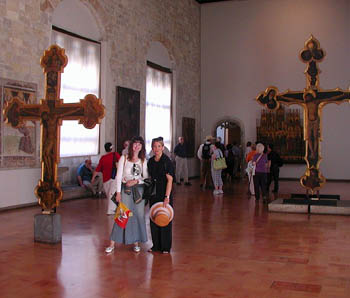 Guide Dianna Mazza with Dr. Florence Russo at San Giovanni Degi Eremiti |
The Sicilian Regional Gallery and Archaeological Museum contains masterpieces of the Greek colonies. On the ground level Selinunte Hall, small architectural statues were displayed from the Greek colony of Selinous. This south-western colony was built by colonists from Megara, Greece. The predominant themes of the art work included: Demeter (Mother Earth) and her daughter Persephone (who was the forced bride of Hades, the underworld king); Heracles (Hercules); Apollo; Perseus slaying the Gorgon; the sacred wedding of Zeus and Hera; and other heroes of Greek mythology. "Sicily is the land of Mythology," said our guide Dianna Mazza. |
Level two of the Archaeological Museum had pottery from the Greek colonies of Gela and Himera. Extraordinary Greek statues of "Hercules killing a deer" and the "Ephebus of Selinunte" mesmerized the spectator. The Byzantine influence is seen in the portrait of "Our lady of the Annunciation" by Antonio de Messina in 1473. "Notice the blue veil of the Lady," said Ms. Mazza. "This is from the Byzantines." I was impressed with the respect the Sicilians have in preserving their Greek-Byzantine treasures. "Monreale has more Byzantine mosaics than any other church in the world," said Dr. Gaetano Cipolla of St. John's University and president of Arba Sicula. The Cathedral built by the Norman king William II has a Latin basilica plan with the Byzantine type cross vault. It was created in 15 years. The mosaics are from the Book of Genesis. Greek and Latin inscriptions are written in the frescoes. Traditional fresco themes are the Pantocrator Christ, Virgin Mary and Child with angels, apostles and saints. |
|
"The Sicilian people preferred the modern Greek language during the Middle Ages with the Greek Orthodox rite," said Dr. Giuseppe Sciano, a famous journalist of Palermo. "Up until 1492, the Orthodox religion remained predominant. King Ferdinand exiled the Jews, Byzantines and Moors in 1492. He obliged all Sicilians to practice Catholicism. From the year 500 B.C., the Sicels, Sicans, Elymi, Punic or Carthaginian populations who lived around Palermo and Trapani, adopted the Greek language and civilization. Even under the Roman occupation, the Sicilioti (as the Sicilians called themselves) used the Greek language to reaffirm their own identity." Arthur Dieli, an international Sicilian scholar, said "in the Odyssey, Homer calls the island of Sicily, Trinakih. This is from the ancient Greek Trinax, meaning the three pointed spear or trident of Poseidon, the god of the sea. The three points of Sicily are the capes of Peloro, Passero and Lilibeo. Trinacria is the name in Sicilian." Visiting Sicily gives one an insight into Hellenism that influenced persons of all backgrounds. |
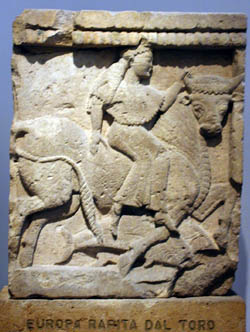 Europa being carried off by the Bull, Palermo Archaeological Museum. |
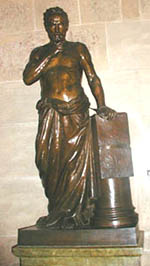 Archimedes, one of the greatest minds of all time, born and raised in Syracuse, Sicily, Archaeological Museum. |
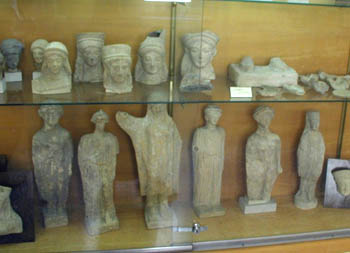 Statues of Demeter and her daughter, Persephone, Palermo Archaeological Museum. |
|
(Posting date 14 May 2006) Catherine Tsounis is currently an Adjunct Professor of Modern Greek at St. John's University in New York. HCS viewers may read other fine articles of hers or view her brief biography at the URL: http://www.helleniccomserve.com/biotsouniscatherine.html. HCS encourages readers to view other articles and releases in our permanent, extensive archives at the URL http://www.helleniccomserve.com/contents.html. |
|
|
|
|
2000 © Hellenic Communication Service, L.L.C. All Rights Reserved.
http://www.HellenicComServe.com |
|
